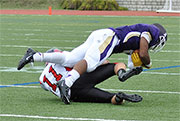- Skip Storing This Everyday Product in the Fridge Door
- Green Tea + B3 Pairing May Boost Brain Health
- Navigating Your Midlife Crisis: Embracing New Possibilities
- City Raccoons Showing Signs of Domestication
- Mapping the Exposome: Science Broadens Focus to Environmental Disease Triggers
- One Week Less on Social Media Linked to Better Mental Health
- Your Brain Changes in Stages as You Age, Study Finds
- Some Suicide Victims Show No Typical Warning Signs, Study Finds
- ByHeart Formula Faces Lawsuits After Babies Sickened With Botulism
- Switch to Vegan Diet Could Cut Your Greenhouse Gas Emissions in Half
Off Season May Not Be Long Enough to Recover From Football ‘Hits’


New research shows that the brains of some football players who had the usual head hits associated with the sport, but no concussions, still had signs of mild brain injury six months after the season ended.
“We followed athletes at the beginning of football season, after and for six months later,” said Dr. Jeffrey Bazarian, an associate professor of emergency medicine at the University of Rochester School of Medicine and Dentistry, in Rochester, N.Y.
Bazarian found white matter changes consistent with mild brain injury generally persisted for six months. “When we looked at players individually, there were a few that looked like they did resolve,” he said, but half of the players still showed changes at the six-month mark.
“We didn’t see these changes in those who don’t play football,” he said. “And these are the kinds of changes that are being found in retired NFL players.”
The latest study is published in the April 16 online issue of PLOS ONE.
For the research, Bazarian evaluated 10 Division III college football players and five college students who did not play sports during the 2011-2012 season. All 15 underwent brain imaging in addition to balance, cognitive (thinking) skills and other testing before the season, at the end of the season and after six months of rest. The athletes were told not to play during the six months, he said, although the researchers can’t be sure everyone followed that instruction.
During the football season, accelerometers mounted to the helmets measured head impacts. The total head impacts for the season ranged from 431 to 1,850, but no one got a diagnosis of concussion.
A concussion is a brain injury that disrupts normal functioning. In recent years, experts have told coaches, players and parents that athletes should not return to play until a doctor evaluates them if a concussion is suspected.
In the new study, the athletes had more changes in white matter from the first measurement to the second, and most of these differences remained at the final measure, six months after play had stopped.
The lack of recovery could contribute to the white matter changes that accumulate over the years with repetitive head impacts, the researchers noted.
“We are obviously trying to understand, are these changes the beginning of this process?” Bazarian said. They also need to find out why some brains recover more quickly, he added.
“Inflammation may be at play,” Bazarian said. “If that’s the case, maybe it’s a case of preventing inflammation. Maybe more than six months of rest is needed.”
The researchers can’t say if the changes are “clinically meaningful,” Bazarian said. “We found no changes in balance or cognition.”
One expert noted there were some limitations to the study.
The findings are “very preliminary,” said Dr. John Kuluz, director of traumatic brain injury and neurorehabilitation at Miami Children’s Hospital. “It’s only a small number of athletes.”
Kuluz added that comparing football players to nonathletes was also not ideal. “It would have been much better having swimmers or track and field athletes, some sport where they are not hit on the head.”
The white matter changes, as the researchers noted, could have been due to physical exertion, not just the impacts to the head.
However, Bazarian said the findings raise questions about whether hits that fall short of concussions can still lead to neurological problems.
If the research bears out in future studies, one solution may be to take football players out of play when head impacts reach a certain number, to protect their brains.
Until more is known, athletes should pay attention to symptoms suggesting a concussion and get medical help if one is suspected. Headaches, trouble with concentration, sensitivity to light or sound and dizziness are common symptoms of a concussion.
Bazarian reports a pending patent on a method of diagnosing concussion.
The study was funded by the National Football League Charities.
More information
To learn more about concussions, visit the American Academy of Pediatrics.
Source: HealthDay
Copyright © 2025 HealthDay. All rights reserved.










